Opportunities and Barriers for Agrivoltaics on Tribal Lands
Abstract
1. Introduction
2. Materials and Methods
2.1. Scoping Study
2.2. Qualitative Data Collection and Analysis
2.3. Suitability Study
3. Results
3.1. Scoping Study Findings
3.2. Interview Findings: Opportunities for Adoption
3.2.1. Food Sovereignty Benefits
3.2.2. Energy Sovereignty Benefits
3.2.3. Economic Development Benefits
3.3. Interview Findings: Barriers to Adoption
3.3.1. Technical Concerns
3.3.2. Economic Concerns
3.3.3. Siting Concerns
3.3.4. Social-Ecological Concerns
3.4. Suitability Study Findings
4. Discussion
Limitations
5. Conclusions
Author Contributions
Funding
Institutional Review Board Statement
Informed Consent Statement
Data Availability Statement
Acknowledgments
Conflicts of Interest
Appendix A
Initial Interview Protocol
- Can you tell me about the first time you thought about pursuing a career in Native agriculture?
- How did you come to be in your current role? [If you’re not currently working in agriculture, how did you come to be in your most recent ag-related role?]
- a.
- How do you describe your role as a _____________?
- b.
- What areas of knowledge or skills are most crucial in your role?
- What areas do you consider to be your region of expertise?
- a.
- What type of agricultural production is found there?
- In your experience, what kind of energy production happens in your region?
- In what ways, if any, do you see agriculture and energy interacting in Tribal communities you are familiar with?
- a.
- How about agriculture interactions with solar energy in particular?
- b.
- What about positive or negative interactions?
- Have you seen any electricity issues in Tribal communities you are familiar with?
- As a quick pulse read, on a scale of 1–5 (with 1 being never heard of it before this study and 5 being very familiar), how familiar are you with agrivoltaics?
- a.
- If familiar, how did you hear about agrivoltaics?
- b.
- When you heard about it, was it in a positive, negative, or neutral context?
- From what you know about agrivoltaics:
- a.
- What is your initial reaction?
- b.
- Does it seem like agrivoltaics could be feasible in your community?
- c.
- How do you think the larger community reacts to the concept?
- d.
- If someone were interested in adopting agrivoltaics, what concerns or challenges do you think they might face?
- What impact might agrivoltaics have on:
- a.
- the productivity of the farm?
- b.
- the environment and/or wildlife?
- c.
- economic development in the area?
- d.
- food access in the area?
- e.
- energy access in the area?
- What are your initial thoughts (including questions you may have) about the scoping analysis map?
- a.
- How does the suitability calculated for your area resonate with your understanding and experience?
- b.
- What factors would you add or change?
- If a Tribal leader called you tomorrow asking for your opinion on agrivoltaics and you only had one minute to think, what would you tell them?
References
- White House. Inflation Reduction Act Guidebook|Clean Energy; White House: Washington, DC, USA, 2023. Available online: https://www.whitehouse.gov/cleanenergy/inflation-reduction-act-guidebook/ (accessed on 30 March 2024).
- White House. Funding for Tribes in the Inflation Reduction Act|Clean Energy; White House: Washington, DC, USA, 2023. Available online: https://www.whitehouse.gov/cleanenergy/tribes/ (accessed on 30 March 2024).
- Doris, E.; Lopez, A.; Beckley, D. Geospatial Analysis of Renewable Energy Technical Potential on Tribal Lands; National Renewable Energy Laboratory: Golden, CO, USA, 2013. Available online: https://www.nrel.gov/docs/fy13osti/56641.pdf (accessed on 30 March 2024).
- Yazzie, K.C.; Whyte, K.; Begay, S.; Glavin, J.; Jones, T.; Leni-Konig, K.; Pratte, C.; Madden, D.; Reicher, D.; Field, C.B. Opportunities to grow tribal clean energy in the US. Science 2024, 384, 163–165. [Google Scholar] [CrossRef] [PubMed]
- U.S. Department of Energy (DOE). SunShot Vision Study. 2012. Available online: https://www.energy.gov/sites/prod/files/2014/01/f7/47927.pdf (accessed on 30 March 2024).
- Adeh, E.H.; Good, S.P.; Calaf, M.; Higgins, C.W. Solar PV Power Potential Is Greatest Over Croplands. Sci. Rep. 2019, 9, 11442. [Google Scholar] [CrossRef] [PubMed]
- Hoffacker, M.K.; Allen, M.F.; Hernandez, R.R. Land-Sparing Opportunities for Solar Energy Development in Agricultural Landscapes: A Case Study of the Great Central Valley, CA, United States. Environ. Sci. Technol. 2017, 51, 14472–14482. [Google Scholar] [CrossRef] [PubMed]
- Dupraz, C.; Marrou, H.; Talbot, G.; Dufour, L.; Nogier, A.; Ferard, Y. Combining Solar Photovoltaic Panels and Food Crops for Optimising Land Use: Towards New Agrivoltaic Schemes. Renew. Energy 2011, 36, 2725–2732. [Google Scholar] [CrossRef]
- Barron-Gafford, G.A.; Pavao-Zuckerman, M.A.; Minor, R.L.; Sutter, L.F.; Barnett-Moreno, I.; Blackett, D.T.; Thompson, M.; Dimond, K.; Gerlak, A.K.; Nabhan, G.P.; et al. Agrivoltaics provide mutual benefits across the food–energy–water nexus in drylands. Nat. Sustain. 2019, 2, 848–855. [Google Scholar] [CrossRef]
- Marrou, H.; Dufour, L.; Wery, J. How does a shelter of solar panels influence water flows in a soil–crop system? Eur. J. Agron. 2013, 50, 38–51. [Google Scholar] [CrossRef]
- Trommsdorff, M.; Kang, J.; Reise, C.; Schindele, S.; Bopp, G.; Ehmann, A.; Weselek, A.; Högy, P.; Obergfell, T. Combining food and energy production: Design of an agrivoltaic system applied in arable and vegetable farming in Germany. Renew. Sustain. Energy Rev. 2021, 140, 110694. [Google Scholar] [CrossRef]
- Andrew, A.C. Lamb Growth and Pasture Production in Agrivoltaic Production System; Oregon State University: Corvallis, OR, USA, 2020. [Google Scholar]
- Lytle, W.; Meyer, T.K.; Tanikella, N.G.; Burnham, L.; Engel, J.; Schelly, C.; Pearce, J.M. Conceptual Design and Rationale for a New Agrivoltaics Concept: Pasture-Raised Rabbits and Solar Farming. J. Clean. Prod. 2020, 282, 124476. [Google Scholar] [CrossRef]
- Faria, A.F.P.A.; Maia, A.S.C.; Moura, G.A.B.; Fonsêca, V.F.C.; Nascimento, S.T.; Milan, H.F.M.; Gebremedhin, K.G. Use of Solar Panels for Shade for Holstein Heifers. Animals 2023, 13, 329. [Google Scholar] [CrossRef]
- Sacchelli, S.; Garegnani, G.; Geri, F.; Grilli, G.; Paletto, A.; Zambelli, P.; Ciolli, M.; Vettorato, D. Trade-off between photovoltaic systems installation and agricultural practices on arable lands: An environmental and socio-economic impact analysis for Italy. Land Use Policy 2016, 56, 90–99. [Google Scholar] [CrossRef]
- Marrou, H.; Guilioni, L.; Dufour, L.; Dupraz, C.; Wery, J. Microclimate under agrivoltaic systems: Is crop growth rate affected in the partial shade of solar panels? Agric. For. Meteorol. 2013, 177, 117–132. [Google Scholar] [CrossRef]
- Amaducci, S.; Yin, X.; Colauzzi, M. Agrivoltaic systems to optimise land use for electric energy production. Appl. Energy 2018, 220, 545–561. [Google Scholar] [CrossRef]
- Weselek, A.; Bauerle, A.; Hartung, J.; Zikeli, S.; Lewandowski, I.; Högy, P. Agrivoltaic system impacts on microclimate and yield of different crops within an organic crop rotation in a temperate climate. Agron. Sustain. Dev. 2021, 41, 59. [Google Scholar] [CrossRef]
- Gonocruz, R.A.; Nakamura, R.; Yoshino, K.; Homma, M.; Doi, T.; Yoshida, Y.; Tani, A. Analysis of the Rice Yield under an Agrivoltaic System: A Case Study in Japan. Environments 2021, 8, 65. [Google Scholar] [CrossRef]
- Max, T.; Vorast, M.; Durga, N.; Padwardhan, S. Potential of Agrivoltaics to Contribute to Socio-Economic Sustainability: A Case Study in Maharashtra/India. AIP Conf. Proc. 2021, 2361, 040001. [Google Scholar] [CrossRef]
- Ravi, S.; Macknick, J.; Lobell, D.; Field, C.; Ganesan, K.; Jain, R.; Elchinger, M.; Stoltenberg, B. Colocation opportunities for large solar infrastructures and agriculture in drylands. Appl. Energy 2016, 165, 383–392. [Google Scholar] [CrossRef]
- Marrou, H.; Wery, J.; Dufour, L.; Dupraz, C. Productivity and radiation use efficiency of lettuces grown in the partial shade of photovoltaic panels. Eur. J. Agron. 2013, 44, 54–66. [Google Scholar] [CrossRef]
- Al-Agele, H.A.; Proctor, K.; Murthy, G.; Higgins, C. A Case Study of Tomato (Solanum lycopersicon var. Legend) Production and Water Productivity in Agrivoltaic Systems. Sustainability 2021, 13, 2850. [Google Scholar] [CrossRef]
- Malu, P.R.; Sharma, U.S.; Pearce, J.M. Agrivoltaic potential on grape farms in India. Sustain. Energy Technol. Assess. 2017, 23, 104–110. [Google Scholar] [CrossRef]
- Al Mamun, M.A.; Dargusch, P.; Wadley, D.; Zulkarnain, N.A.; Aziz, A.A. A review of research on agrivoltaic systems. Renew. Sustain. Energy Rev. 2022, 161, 112351. [Google Scholar] [CrossRef]
- Pascaris, A.S.; Schelly, C.; Pearce, J.M. A First Investigation of Agriculture Sector Perspectives on the Opportunities and Barriers for Agrivoltaics. Agronomy 2020, 10, 1885. [Google Scholar] [CrossRef]
- Pascaris, A.S.; Schelly, C.; Burnham, L.; Pearce, J.M. Integrating solar energy with agriculture: Industry perspectives on the market, community, and socio-political dimensions of agrivoltaics. Energy Res. Soc. Sci. 2021, 75, 102023. [Google Scholar] [CrossRef]
- Irie, N.; Kawahara, N.; Esteves, A.M. Sector-wide social impact scoping of agrivoltaic systems: A case study in Japan. Renew. Energy 2019, 139, 1463–1476. [Google Scholar] [CrossRef]
- Biggs, N.B.; Shivaram, R.; Lacarieri, E.A.; Varkey, K.; Hagan, D.; Young, H.; Lambin, E.F. Landowner decisions regarding utility-scale solar energy on working lands: A qualitative case study in California. Environ. Res. Commun. 2022, 4, 055010. [Google Scholar] [CrossRef]
- Stang, J. Solar-Powered Microfarm Is Washington’s First Agrivoltaics Project|Energy News Network. Energy News Network. 2022. Available online: https://energynews.us/2022/06/22/on-washingtons-colville-reservation-solar-powered-microfarm-looks-to-prove-model-to-boost-food-energy-sovereignty/ (accessed on 30 March 2024).
- Gorelick, N.; Hancher, M.; Dixon, M.; Ilyushchenko, S.; Thau, D.; Moore, R. Google Earth Engine: Planetary-scale geospatial analysis for everyone. Remote Sens. Environ. 2017, 202, 18–27. [Google Scholar] [CrossRef]
- Hernandez, R.R.; Hoffacker, M.K.; Field, C.B. Efficient use of land to meet sustainable energy needs. Nat. Clim. Chang. 2015, 5, 353–358. [Google Scholar] [CrossRef]
- Sandelowski, M. Using Qualitative Research. Qual. Heal. Res. 2004, 14, 1366–1386. [Google Scholar] [CrossRef]
- Knott, E.; Rao, A.H.; Summers, K.; Teeger, C. Interviews in the social sciences. Nat. Rev. Methods Prim. 2022, 2, 1–15. [Google Scholar] [CrossRef]
- Corbin, J.; Strauss, A. Basics of Qualitative Research (3rd ed.): Techniques and Procedures for Developing Grounded Theory; SAGE Publications, Inc.: Sauzend Oaks, CA, USA, 2008. [Google Scholar] [CrossRef]
- Willig, C. Introducing Qualitative Research in Psychology; McGraw-Hill Education: London, UK, 2013. [Google Scholar]
- Hansen, M.C.; Potapov, P.V.; Pickens, A.H.; Tyukavina, A.; Hernandez-Serna, A.; Zalles, V.; Turubanova, S.; Kommareddy, I.; Stehman, S.V.; Song, X.-P.; et al. Global land use extent and dispersion within natural land cover using Landsat data. Environ. Res. Lett. 2022, 17, 034050. [Google Scholar] [CrossRef]
- Reinermann, S.; Asam, S.; Kuenzer, C. Remote Sensing of Grassland Production and Management—A Review. Remote Sens. 2020, 12, 1949. [Google Scholar] [CrossRef]
- Energy Sector Management Assistance Program. Global Solar Atlas 2.0: Technical Report; World Bank Group: Washington, DC, USA, 2019; Available online: http://documents.worldbank.org/curated/en/529431592893043403/Global-Solar-Atlas-2-0-Technical-Report (accessed on 30 March 2024).
- Majumdar, D. Planning for the Energy Transition: Solar Photovoltaics in Arizona. Ph.D. Thesis, Arizona State University, Tempe, AZ, USA, 2018. Available online: https://www.proquest.com/docview/2154878428/abstract/FE0FCF5FBE9A414FPQ/1 (accessed on 30 March 2024).
- Andrew, A.C.; Higgins, C.W.; Smallman, M.A.; Graham, M.; Ates, S. Herbage Yield, Lamb Growth and Foraging Behavior in Agrivoltaic Production System. Front. Sustain. Food Syst. 2021, 5, 659175. Available online: https://www.frontiersin.org/articles/10.3389/fsufs.2021.659175 (accessed on 30 March 2024). [CrossRef]
- Begay, S.K.; Begay, S.K. Navajo residential solar energy access as a global model. Electr. J. 2018, 31, 9–15. [Google Scholar] [CrossRef]
- O’Connor, J.E.; Duda, J.J.; Grant, G.E. 1000 dams down and counting. Science 2015, 348, 496–497. [Google Scholar] [CrossRef]
- Mead, R.; Willey, R.W. The Concept of a ‘Land Equivalent Ratio’ and Advantages in Yields from Intercropping. Exp. Agric. 1980, 16, 217–228. [Google Scholar] [CrossRef]
- Mavani, D.D.; Chauhan, P.; Joshi, V. Beauty of Agrivoltaic System Regarding Double Utilization of Same Piece of Land for Generation of Electricity & Food Production. 2019. Available online: https://www.semanticscholar.org/paper/Beauty-of-Agrivoltaic-System-regarding-double-of-of-Mavani-Chauhan/aec1fd08684d7e7edb4ae06620389317eaba387a (accessed on 30 March 2024).
- Shoemaker, J.A. No Sticks in My Bundle: Rethinking the Indian Land Tenure Problem. Kans. Law Rev. 2014, 63, 383–450. [Google Scholar]
- Proctor, K.W.; Murthy, G.S.; Higgins, C.W. Agrivoltaics Align with Green New Deal Goals While Supporting Investment in the US’ Rural Economy. Sustainability 2021, 13, 137. [Google Scholar] [CrossRef]

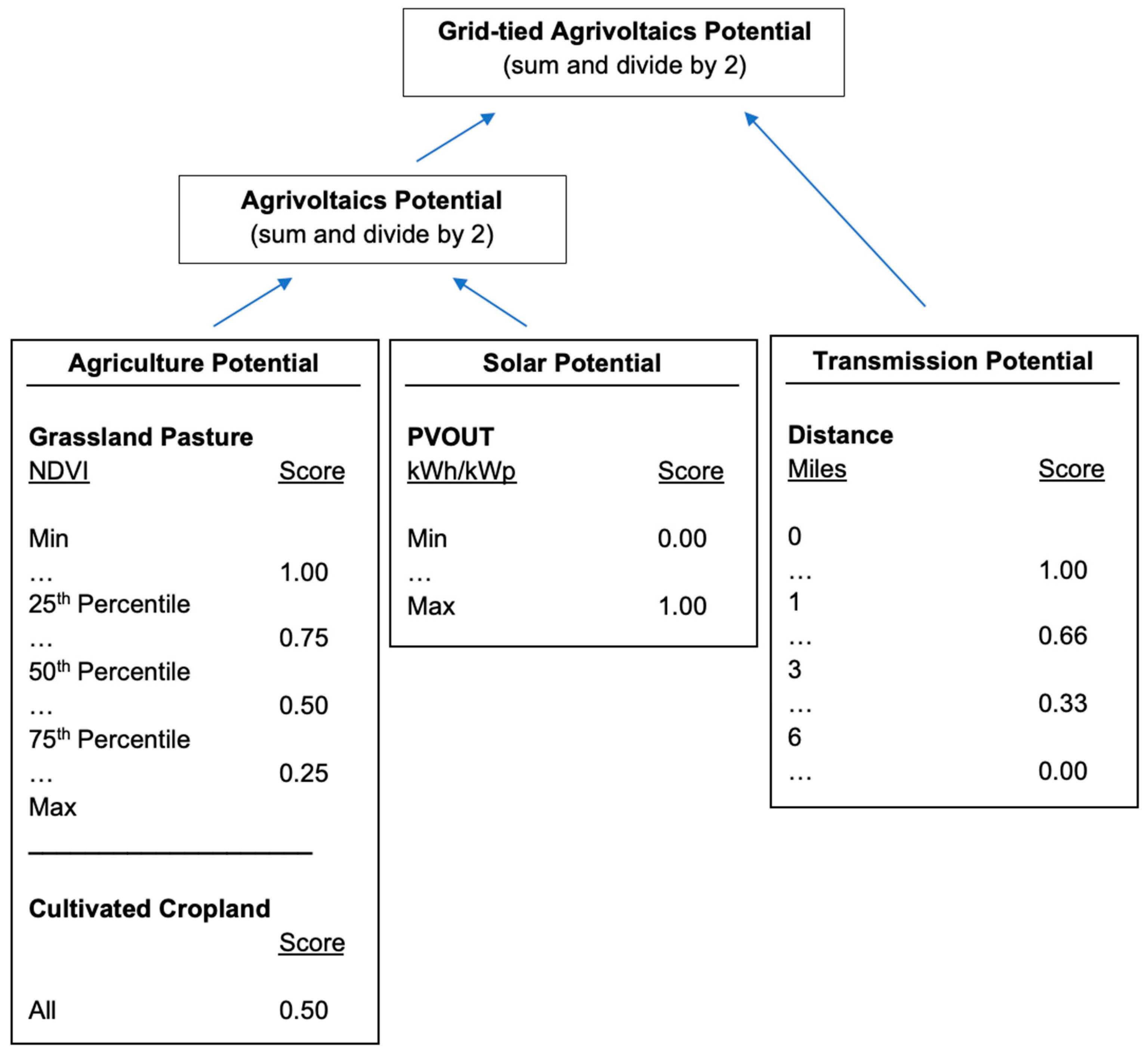
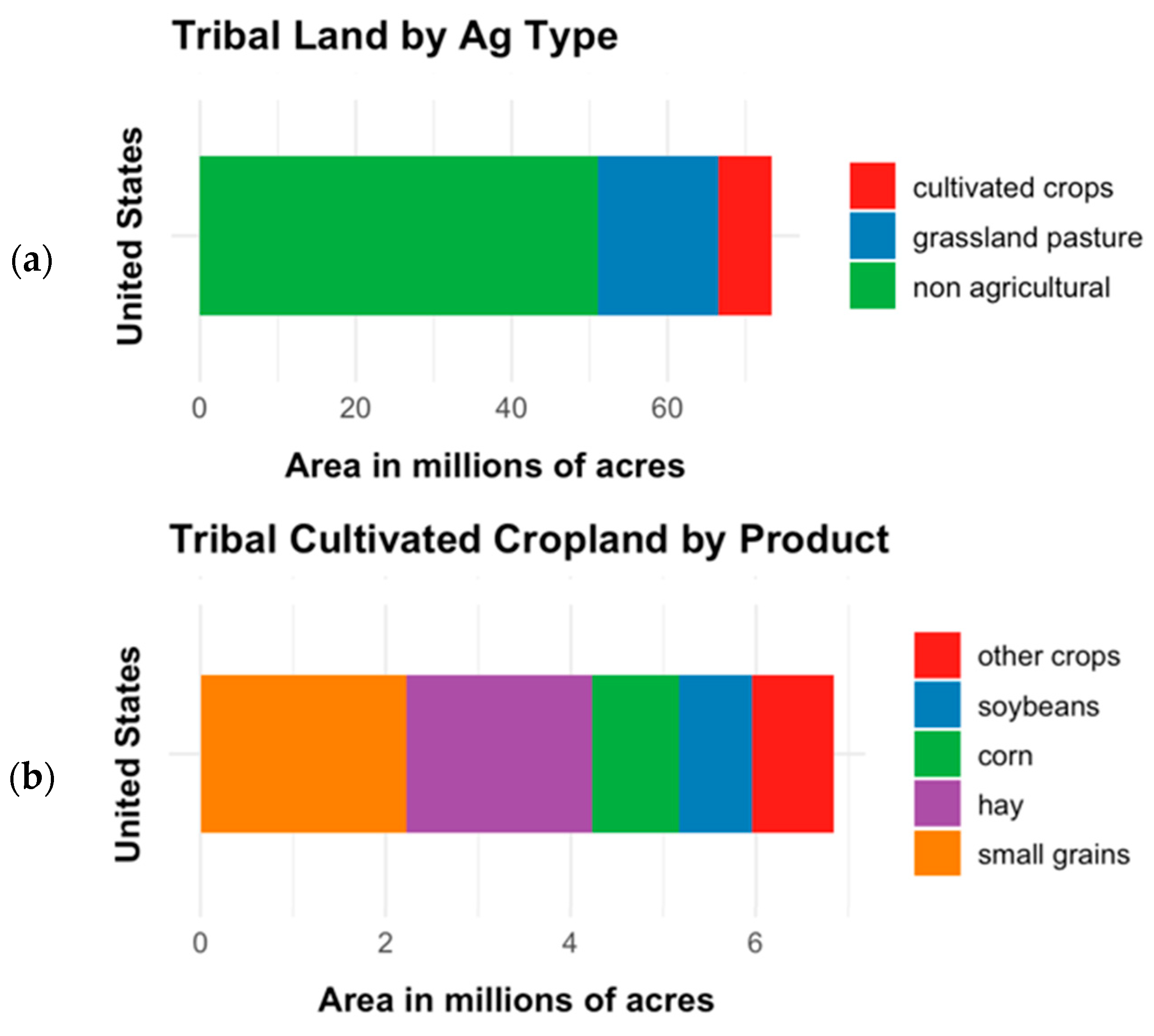
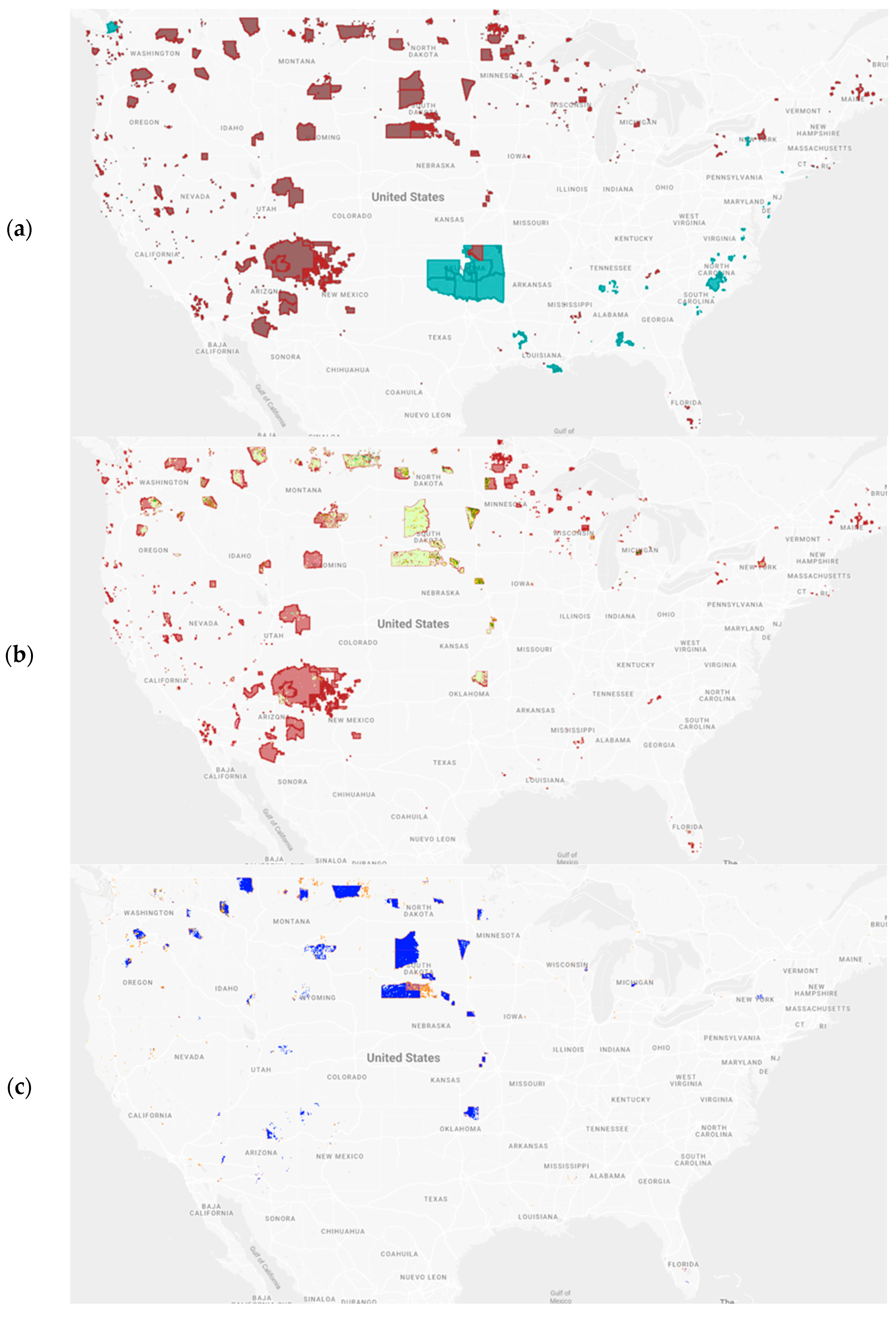
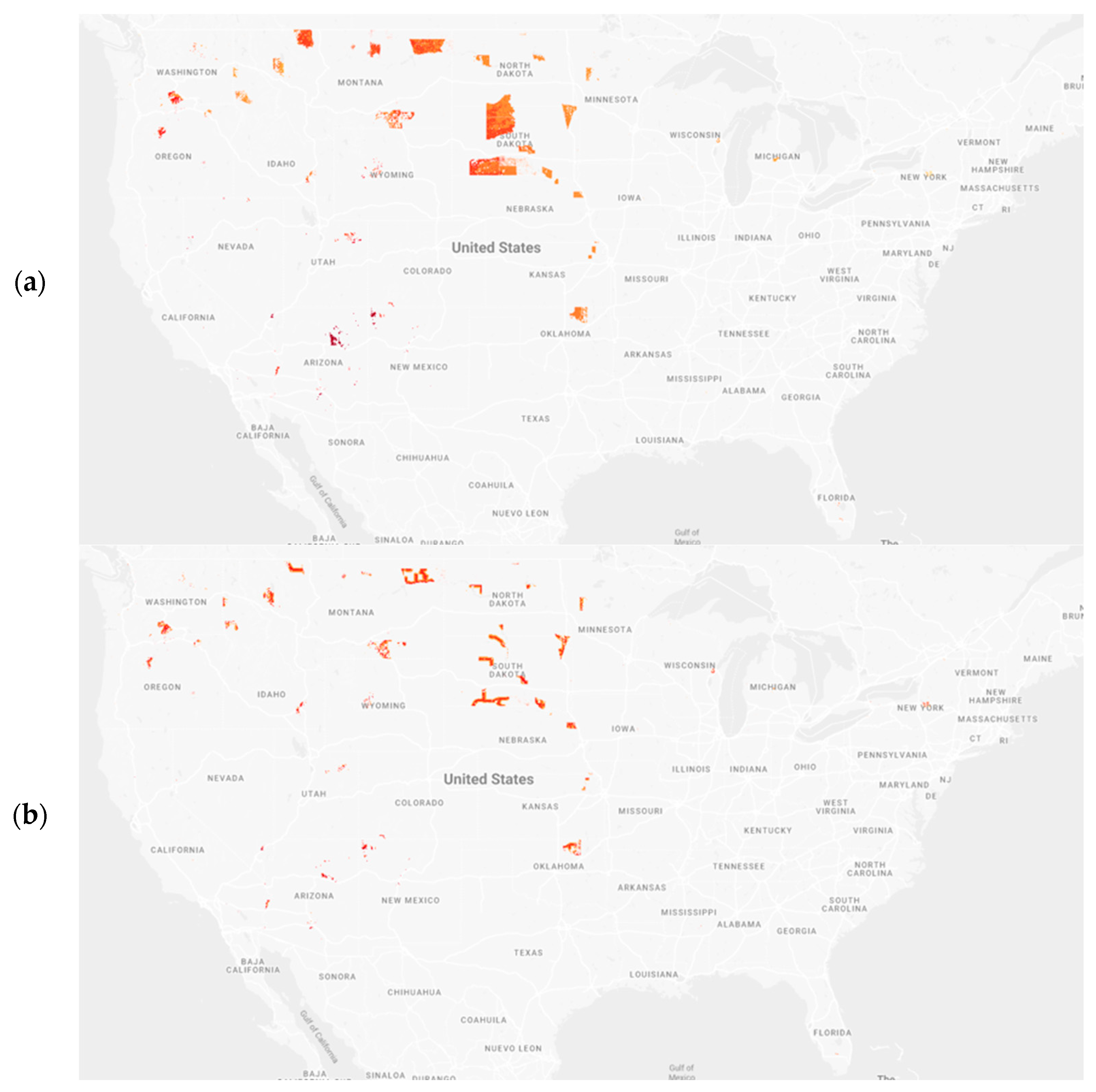
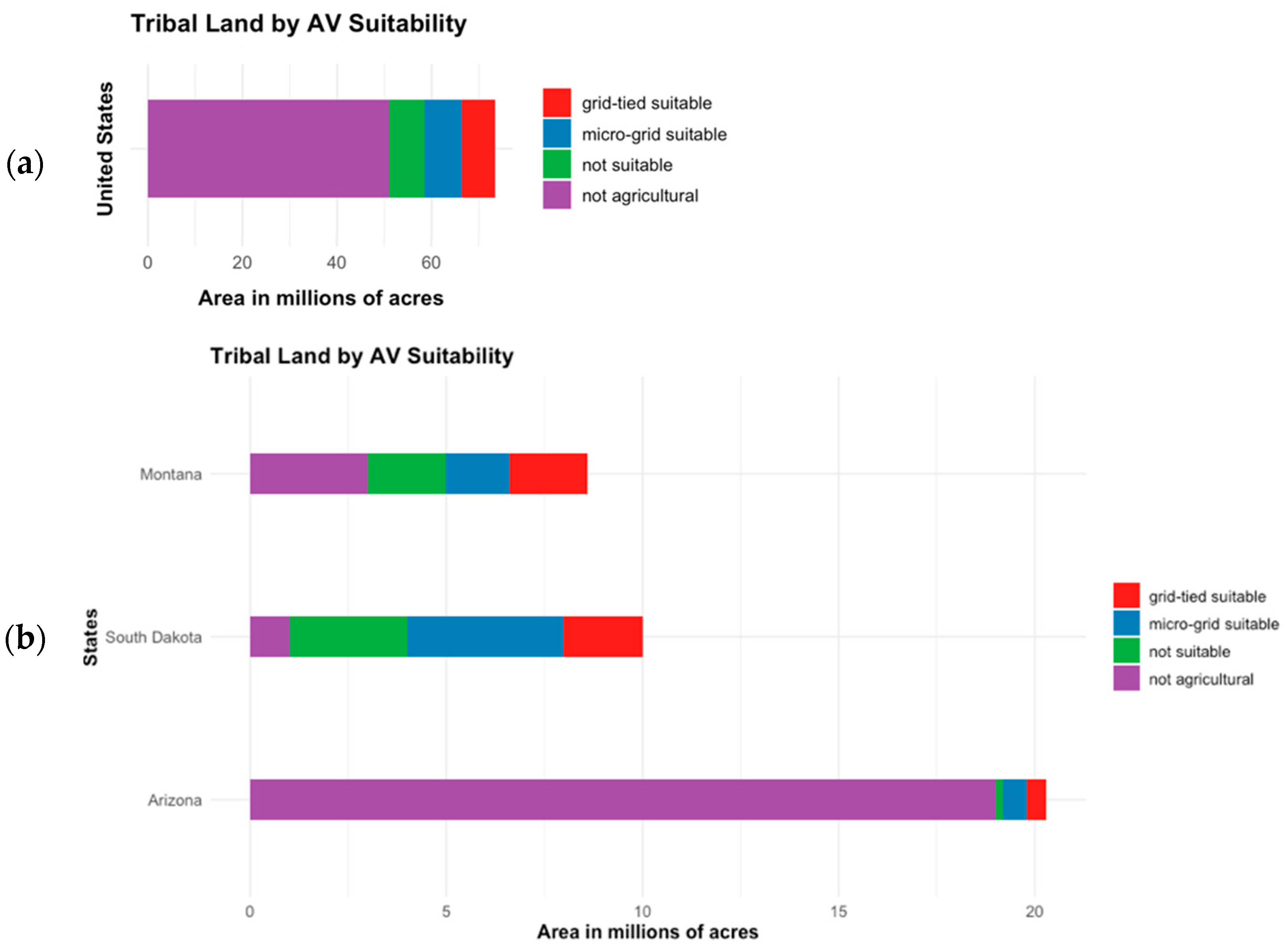
| Parameter | Dataset |
|---|---|
| Tribal land base | US Census Bureau AIANNH Areas |
| Agricultural land use | USDA Cropland Data Layer |
| Slope | SRTM Digital Elevation Data V4 |
| Sector | Location | Gender | Age | Producer Status |
|---|---|---|---|---|
| Nonprofit: 15 | Eastern US: 3 | Female: 11 | 18–29: 7 | Current: 10 |
| Academia: 3 | Great Plains: 4 | Male: 10 | 30–49: 10 | Former: 2 |
| Private: 2 | Rocky Mountains: 3 | 50–69: 3 | Never: 9 | |
| Public: 1 | Southwest US: 6 | 70+: 1 | ||
| Pacific Coast: 5 |
| Area (1000 Acres) | % of Subtotal | ||
|---|---|---|---|
| Tribal agricultural area | Cropland | 6790 | 31% |
| Pastureland | 15,415 | 69% | |
| Subtotal | 22,205 | - | |
| Tribal agrivoltaics potential | Cropland | 5920 | 39% |
| Pastureland | 9297 | 61% | |
| Subtotal | 15,217 | - |
| Concern | Count |
|---|---|
| Technical | 15 |
| Economic | 19 |
| Siting | 18 |
| Socio-ecological | 15 |
| AV Feasible Land | |
| Top states | 100,000 acres |
| (1) South Dakota | 63.8 |
| (2) Montana | 33.8 |
| (3) Arizona | 10.9 |
| (4) North Dakota | 10.8 |
| (5) Oklahoma | 6.6 |
| (6) New Mexico | 4.5 |
| (7) Idaho | 3.0 |
| (8) Minnesota | 2.7 |
| (9) Washington | 2.6 |
| (10) Utah | 2.5 |
| Grid-tied AV feasible land | |
| Top states | 100,000 acres |
| (1) South Dakota | 23.1 |
| (2) Montana | 17.9 |
| (3) Arizona | 4.7 |
| (4) Oklahoma | 4.5 |
| (5) North Dakota | 4.1 |
| (6) New Mexico | 3.7 |
| (7) Washington | 2.3 |
| (8) Idaho | 2.0 |
| (9) Minnesota | 1.9 |
| (10) Nebraska | 1.6 |
| AV priority land | |
| Top states | 100,000 acres |
| (1) South Dakota | 29.0 |
| (2) Montana | 18.1 |
| (3) Arizona | 10.9 |
| (4) New Mexico | 4.5 |
| (5) Oklahoma | 3.5 |
| (6) Utah | 2.5 |
| (7) Wyoming | 1.8 |
| (8) Washington | 1.1 |
| (9) North Dakota | 1.0 |
| (10) Oregon | 0.9 |
| Grid-tied AV priority land | |
| Top states | 100,000 acres |
| (1) South Dakota | 11.1 |
| (2) Montana | 9.1 |
| (3) Arizona | 4.0 |
| (4) New Mexico | 3.5 |
| (5) Oklahoma | 2.4 |
| (6) Minnesota | 1.8 |
| (7) North Dakota | 1.5 |
| (8) Washington | 1.2 |
| (9) Idaho | 1.1 |
| (10) Utah | 1.0 |
| Theme | Findings | Sample Quote | Recommendation |
|---|---|---|---|
| Durability | Participants questioned the durability of AV infrastructure given various hazards on working lands. | “How tough is the agrivoltaics equipment? Because someone is totally backing a tractor into it at some point”. (P6) | Sponsor pilot projects to test AV infrastructure in a variety of production systems. |
| Complexity | Participants expressed concerns about increased knowledge and management burdens for producers. | “Your practices will have to adapt. Understanding what you can and can’t do versus having a wide-open piece of land is going to be a major thing”. (P2) | Scale up extension services to provide evidenced-based recommendations to producers. |
| Productivity | Participants worried that AV installations would hinder their land productivity. | “I would be worried that the rain isn’t going to hit parts of the field and the panels would cause runoff to pool into one spot”. (P15) | Invest in robust research programs to measure and mitigate impacts to productivity. |
| Financing | Participants anticipated challenges raising large sums of capital for AV given the socio-economic landscape in Tribal areas. | “I like the idea, but I think the upfront cost will turn a lot of people off. It’s really expensive to do solar”. (P16) | Explore opportunities to fund AV through existing set-asides for clean energy development on Tribal lands. |
| Market | Participants did not think utility companies would want to purchase energy from AV. | “You have all this excess energy, but who is going to buy it? Will the utility commission even allow us to sell surplus energy to other people?” (P10) | Consider incentives for utility companies to cooperate with AV operators in their service area. |
| Labor | Participants shared how the acute shortage of trained workers in Tribal areas could constrain AV implementation. | “We have a human resources capacity problem in Tribal areas”. (P13) | Develop comprehensive training material that can be delivered to interested parties in rural areas. |
| Land tenure | Participants saw land tenure complexities as a major hurdle for AV implementation. | “Land restrictions would probably be the number one issue that we would run up against”. (P2) | Partner with Tribes on proposals to streamline land use and development. |
| Leasing | Participants expected challenges implementing AV on land leased through the Bureau of Indian Affairs (BIA). | “It’s a big, big hurdle with BIA land management to put in infrastructure, or even just to generally operate”. (P6) | Direct resources to alleviate bureaucratic backlogs and increase responsiveness to Tribal clients. |
| People | Participants emphasized that potential AV projects would need to benefit the whole community, not just interested parties. | “What are the community’s likes, the community’s passions? How can it benefit the community beyond the money sense?” (P18) | Make space for stakeholder input and create a holistic framework for assessing community benefit. |
| Nature | Participants voiced concerns about the well-being of plants, animals and water in proximity to AV systems. | “How will wildlife be impacted by this? I feel like people don’t consider that many tribes are very respectful of all wildlife, even animals that may be thought of as vermin by others”. (P16) | Prioritize technology and design solutions that minimize disruption to the ecosystem. |
Disclaimer/Publisher’s Note: The statements, opinions and data contained in all publications are solely those of the individual author(s) and contributor(s) and not of MDPI and/or the editor(s). MDPI and/or the editor(s) disclaim responsibility for any injury to people or property resulting from any ideas, methods, instructions or products referred to in the content. |
© 2024 by the authors. Licensee MDPI, Basel, Switzerland. This article is an open access article distributed under the terms and conditions of the Creative Commons Attribution (CC BY) license (https://creativecommons.org/licenses/by/4.0/).
Share and Cite
Moore, K.A.; Lobell, D.B. Opportunities and Barriers for Agrivoltaics on Tribal Lands. Sustainability 2024, 16, 5414. https://doi.org/10.3390/su16135414
Moore KA, Lobell DB. Opportunities and Barriers for Agrivoltaics on Tribal Lands. Sustainability. 2024; 16(13):5414. https://doi.org/10.3390/su16135414
Chicago/Turabian StyleMoore, Karli A., and David B. Lobell. 2024. "Opportunities and Barriers for Agrivoltaics on Tribal Lands" Sustainability 16, no. 13: 5414. https://doi.org/10.3390/su16135414
APA StyleMoore, K. A., & Lobell, D. B. (2024). Opportunities and Barriers for Agrivoltaics on Tribal Lands. Sustainability, 16(13), 5414. https://doi.org/10.3390/su16135414







